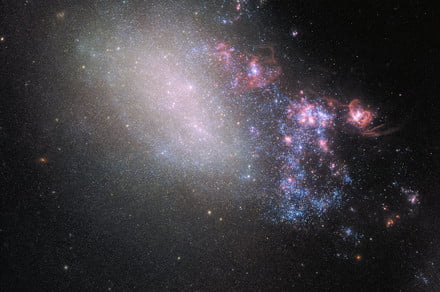NGC 4485, a galaxy colliding with its neighbor, NGC 4490, which is located beyond the frame to the bottom right of the image. ESA/Hubble, NASA
As galaxies move across the universe, they sometimes interact and even collide when they come close enough to each other. In some cases, we can see evidence of nearby galactic neighbors in the effects on the shape and star production of a galaxy.
This is one such case, captured recently by the Hubble Space Telescope. The irregular galaxy NGC 4485 is located approximately 30 million light-years away from us, in the constellation of Canes Venatici (the Hunting Dogs), and its unusual shape is due to the gravitational forces exerted by the nearby and much larger galaxy NGC 4490. You can’t see NGC 4490 in this image as it’s out of frame, located at the bottom right of the image, but you can see the effect it has had on the smaller NGC 4485.
NGC 4485 has been pulled into an elongated shape by gravitational forces, and this disruption has also changed the way that dust and gas are distributed throughout the galaxy. There are now clumps and streams of matter, where before it was spread more evenly across the space. This has given rise to an area of vigorous star activity, with many newborn hot blue stars located to the right of the center of the image.
Sometimes two galaxies come close together will merge or destroy each other, but not in this case. The galaxies have come as close to each other as they are going to and are now moving away from each other, creating a “tug of war” where both sides are pulling at the material located between them.
This tug of war has resulted in the two galaxies being connected by a stream of matter 25,000 light-years long, made up of both pockets of gas and regions of star formation. However, the stars born here won’t survive for long, as they are so bright and energetic that they will quickly burn through all of their fuel.
This isn’t a purely destructive process though, as the event will enrich the local cosmic environment with heavy elements and will distribute the material which will eventually go on to become the next generation of stars.
Editors’ Recommendations
- Hubble captures two colliding galaxies merging to form a super-galaxy
- Gravitational forces at heart of Milky Way shaped this star cluster like a comet
- It can be either death or glory when two galaxies collide
- Hubble captures an archetypal spiral galaxy in the constellation of Leo
- Step into the center of the galaxy with NASA’s 360-degree visualization

